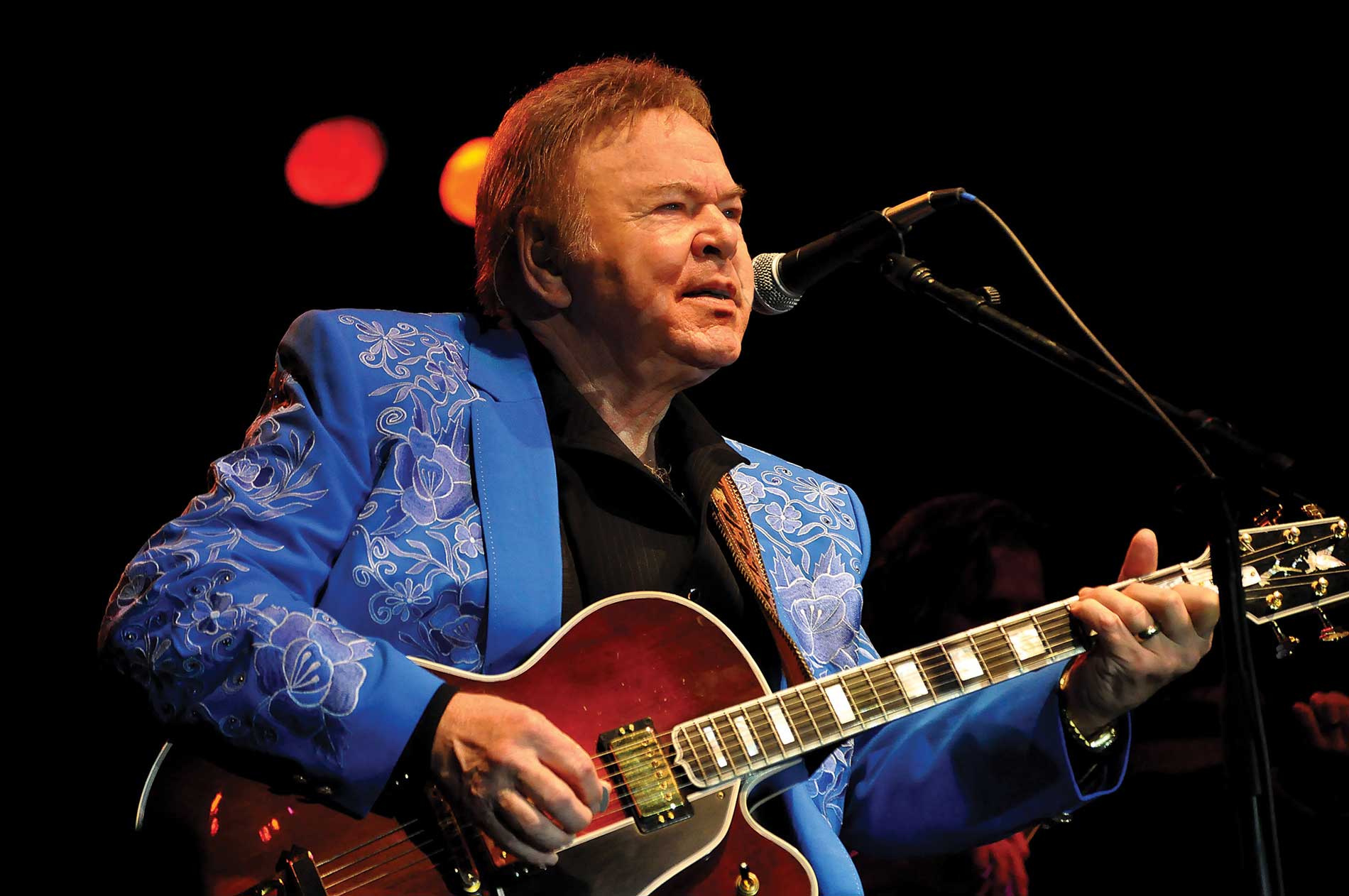As far as country-music impresario Jim Halsey is concerned, the city of Claremore is a perfect place for an exhibition on his famed client and friend, Roy Clark. After all, Clark not only deeply admired Claremore’s favorite son, the celebrated Will Rogers; he was also, in 2005, grand marshall of the town’s annual Will Rogers Days parade.
“Roy was a big, big fan of Will Rogers,” explains Halsey, Clark’s longtime manager. “And he got to ride in the parade for Will, so there’s a real connection there. Plus, I don’t know of two more loved and respected Americans than Will Rogers and Roy Clark. What two people pair up better? That’s America, buddy.”
It’s also Claremore, now that the city’s J.M. Davis Arms and Historical Museum has opened its exhibit, The Story of Roy Clark, a little more than a mile away from where the Will Rogers Memorial Museum has long stood on a hill, overlooking the town. The latter is the permanent repository for Rogers’ artifacts, while the Clark exhibit at the Davis Museum is scheduled to last “about a year,” according to Halsey, who works out of his offices a couple of dozen miles down the road in Tulsa.
For decades, Clark was also a T-Town resident, and Halsey notes that efforts are underway to find “a permanent home” for the collection in their shared hometown. In the meantime, he says, “We have all this memorabilia that we need to do something with. So, what better place to do it than in a state-of-the-art exhibition space in Oklahoma? This gives Tulsans and people from the Tulsa area an opportunity to renew their acquaintance with Roy through physical objects – posters and albums and guitars and clothing, awards and citations. They can see all the contributions this man made, not only to American music and American entertainment, but specifically to Tulsa and the whole Oklahoma area.”
Visitors will indeed find an intriguing array of Roy Clark material in the Davis Museum exhibit, from a pair of overalls and a banjo that he used during his long run on TV’s Hee Haw to custom and antique rifles to a special trading card.
That latter item particularly delighted the museum’s executive director Wayne McCombs, a well-known baseball expert who’s written extensively on the subject.
“We’ve got the bubblegum card [from 1961] celebrating the 565-foot home run that Mickey Mantle hit at Griffith Stadium in Washington, D.C.,” McCombs notes. “Roy saw him hit it. He was in the stands with his dad that day.”
By the time Mantle launched that monumental blast, the Clark family – originally from Virginia – had been living in D.C. for more than 15 years, where his father, a onetime farmer, had found work at the Washington Navy Yard. It wasn’t until the early ‘70s that Clark, by then an internationally known entertainer whose career had been guided for years by Halsey, moved to Tulsa, where Halsey was busy building up his Jim Halsey Company. (By the mid-’80s, it would be the biggest country-music agency in the world.) Clark remained a Tulsa resident until his 2018 death, lending his name, presence and talent to – among other local endeavors – a nine-year run of annual Roy Clark Celebrity Golf Tournaments and concurrent Star Night concerts, all benefiting Tulsa’s Children’s Medical Center.
As impressive and star-studded as those events were, they make up only a small part of Roy Clark’s legacy – which is something that the museum’s executive director McCombs and curator Jason Schubert quickly realized when they began looking into the idea of a Clark exhibit.
“It started around Thanksgiving, when Jim gave me a call about it,” remembers McCombs. “He told me that Roy had a lot of hunting rifles and some antique stuff from the Civil War era that we might be interested in displaying. Then, we started talking about Roy’s awards.”
Eventually, Schubert and McCombs visited the Clark home in Tulsa to take a look at some of Roy’s mementos. There, they were met by Julia Staires, Roy’s longtime office manager who, McCombs says, was assisting Barbara Clark, Roy’s widow.
“We started with the rifles,” Schubert remembers. “But as we looked at everything he had and saw just what was there, we said, ‘We really need to tell this story.’ That’s how it began to develop into The Story of Roy Clark.”
Adds McCombs: “We saw those awards and realized that each one of them was a milestone. We thought people needed to see them. So, we asked if we could use them, and they said, ‘Sure.’ Once we had permission, Jason and I started pulling them off the walls and wrapping them in bubble wrap.”
At one point, Halsey asked if they’d like to use any of Clark’s stage costumes.
“We said we’d take a couple,” says Schubert with a chuckle. “He got us six, including, best of all, those Hee Haw overalls.”
Some of the items in the exhibit, including a platinum record (signifying sales of more than a million copies) of his 1969 single “Yesterday, When I Was Young,” will be familiar to even casual Roy Clark fans. Other pieces, however, may offer surprises to the exhibit’s visitors.
There is, for instance, a photo and helmet that reflected Clark’s passion for drag racing. Taken at a track in the Ozarks, the picture shows him and his car, with “Super Picker” emblazoned on the side. There’s also a section devoted to Clark’s love of baseball – which includes the trading card mentioned earlier. Clark was not only one of the owners of the Tulsa Drillers for many years; he’d been a good-enough player himself to earn a tryout with the St. Louis Browns.
“He really had a lot to do with saving professional baseball in Tulsa, too,” says McCombs. “Back in 1979, they needed a new stadium. Roy put together a telethon, on Channel 2, that raised $106,000 toward that goal. And he was part-owner of the Drillers from ‘77 until after the ‘82 season.”
Yet, while McCombs is proud of the baseball component, his favorite part is the video-highlight reel put together for the exhibit – especially the footage of Clark’s character Myrtle Halsey (the last name was no accident) on The Beverly Hillbillies TV show.
“I remember back when I was a disc jockey [on radio station KVOO], visiting with Roy and telling him how I watched him on The Beverly Hillbillies with my family, when I was growing up,” McCombs says. “He told me that he’d gotten his first screen kiss, from [his co-star] Donna Douglas, when he was playing Myrtle Halsey.”
While McCombs had the opportunity to meet and visit with Clark – along with spinning his records as a deejay – Schubert knew Clark mostly through Hee Haw, which remained a popular syndicated program for decades. Now that he’s had a chance to look more deeply into Clark’s career, he admits to being “amazed” by the man.
“I didn’t realize the extent of musical talent that Roy Clark had,” he says. “I didn’t realize how tremendous of a musician he was – what a great talent he was.”
McComb adds: “When we went to his home, and got to see all his awards – well, it was unbelievable. All these awards, for years and years and years. And then, all that he gave back. The charity golf tournaments and the Children’s Medical Center and all that. It was just fantastic. He didn’t have to do that. He was already a welcomed, accepted Okie. But he kept going and going. He really was an amazing individual.”
That evaluation isn’t only shared by the J.M. Davis Museum’s curator and executive director; it’s also reflected beautifully in their new exhibit – a fitting tribute to one of Oklahoma’s all-time great adopted sons.



























